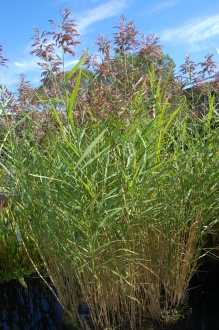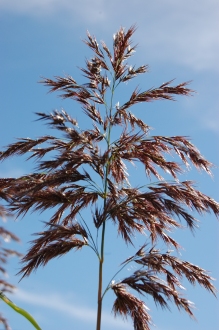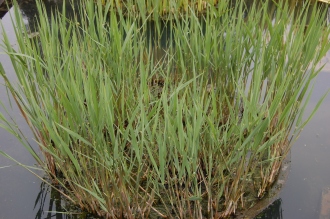Position: Full sun
Soil: Moist, wet soil
Flowering period: Summer
Eventual Height: 4m
Eventual Spread: 4m
Hardiness: 4a, 4b, 5a, 5b, 6a, 6b, 7a, 7b, 8a, 8b, 9a, 9b, 10a, 10b
Family: Poaceae
Phragmites australis is a perennial grass with a tufted habit. Its erect culms bear overlapping sheaths of linear, green/ glaucus leaves which become light brown in autumn. In late summer its inflorescence takes the form of terminal dark purple flowering panicles, densely composed from spikelets. It spreads by underground runners which put down roots and where conditions are suitable it may spread up to 5m per year.
Phragmites australis, commonly known as the Common Reed, is a cosmopolitan species ranging across the globe although there is discussion on the topic of separating it into distinct species based on genetic evidence. The plant is currently widely used in the remediation of sewage water and various types of grey water through the use of constructed wetlands. This plant will grow in freely drained soil to water to a depth of 1m. Phragmites australis subsp. australis is a problem wetland species in North America and the native Phragmites australis subsp. americanus should be specified in this location. For more information on this pant and its identification please see the Phragmites Field Guide.
Phragmites is derived from the Greek phragma, meaning a ‘fence’ or ‘screen’, with australis being a Latinised word meaning ‘of or from Australia’.
The landscape architect may find Phragmites australis useful for both terrestrial and water planting, and especially when used in the remediation of spoiled water in the form of formal or informal water treatment beds. Careful consideratyion should be given when specifying this plant and locating this plant as it is potentialy invasive when planted near damp grassland when not grazed by cattle. In waterbodies Phragmites australis can be grown in large containers to restrict its growth and spread. This plant associates well with river edges, wildflower meadows and wildlife landscapes.
Phragmites australis will tolerate almost any soil conditions; it will be happy at neutral, alkaline or acid pH levels, in loam, clay, chalk or sand based soils, in a west or south facing, sheltered or exposed aspect.
Ecologically, Phragmites australis will attract various species of birds that will use it as cover from predators.
Phragmites australis requires little to no maintenance. It may be cut back to ground level in late autumn or winter.








“Thick stands of Phragmites form nearly impenetrable barriers to the movement of animals and large birds such as ducks, shorebirds, and wading birds. These thick monotypic stands result in a degradation of habitat by raising the marsh elevation and by filling in the open water areas. This habitat loss starts the decline in the diversity of bird species utilizing a marsh. … Although a few bird and animal species such as rail, American bittern, Red-winged blackbird, deer and muskrat may inhabit Phragmites marshes, most other animals and birds avoid these areas because they cannot penetrate the thick stands.
The shade from these large stands also hinders the growth of native plants. Studies have shown that plant diversity is greatly reduced after forming dense monocultures of Phragmites, and that it appears to bedetrimental to the overall ecological functioning of tidal wetlands.”
Frank, thanks for your comments. I would be interested to know if your comments refer to Phragmites in North America. It is my understanding that in North America the European introduced species Phragmites australis subsp. australis is a problem wetland species. The indigenous species Phragmites australis subsp. americanus, as it is a native plant, is not.
Please specify the species in your recomendation since the average person doesn’t know the difference between the two. Phramites australis australis is a federally listed noxious weed and is not rec. to plant period due to it’s high likelyhood of becoming a problem.
Lindsay, I have added some additional text within the post, I hope this addresses your concerns.
I would remove this from your list. So often subspecies get mixed and cause irreparable damage. Even for seasoned professionals. There are plenty of bio remediation alternative species. This choice in my opinion is irresponsible.